Project Management Plan Report: BUSM1278, Sem 1, 2018, University
VerifiedAdded on 2023/03/30
|28
|3245
|404
Report
AI Summary
This document presents a comprehensive Project Management Plan (PMP) created for a BUSM1278 assignment. It meticulously outlines various aspects crucial for successful project execution. The PMP begins with an introduction and executive summary, followed by detailed sections on scope management, stakeholder management, and communication management, detailing approaches, roles, and responsibilities, along with communication registers and conflict management strategies. It then progresses to change control, schedule/time management, and cost/budget management, including schedule development and cost control measures. Furthermore, the plan covers procurement, human resource, quality, risk, occupational health and safety, and environmental management, each with its introduction, approach, roles, and control mechanisms. The document includes various tables, registers, and matrices to provide clarity and structure. The assignment is a complete project management plan template, which provides a detailed framework for managing the project lifecycle from initiation to closing.
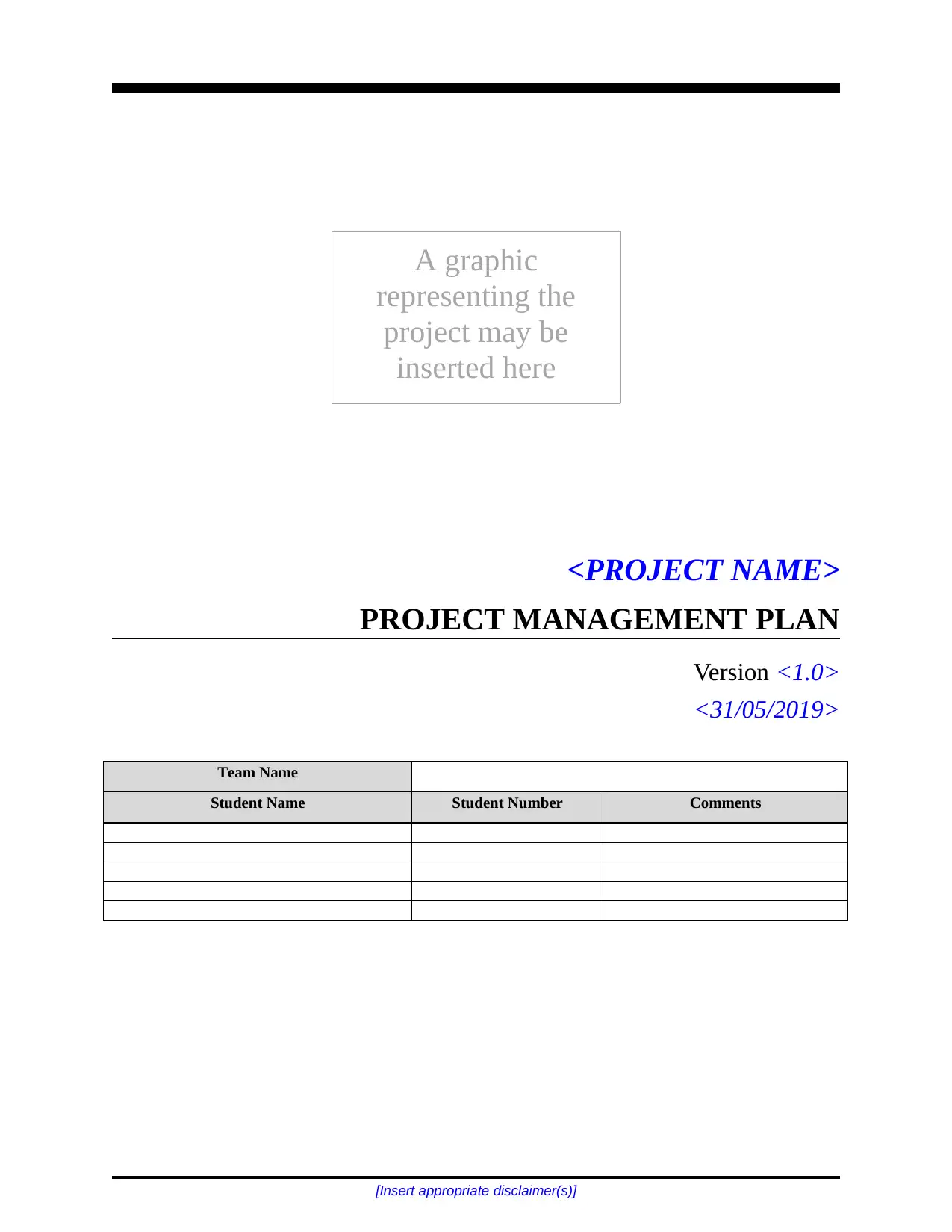
<PROJECT NAME>
PROJECT MANAGEMENT PLAN
Version <1.0>
<31/05/2019>
Team Name
Student Name Student Number Comments
[Insert appropriate disclaimer(s)]
A graphic
representing the
project may be
inserted here
PROJECT MANAGEMENT PLAN
Version <1.0>
<31/05/2019>
Team Name
Student Name Student Number Comments
[Insert appropriate disclaimer(s)]
A graphic
representing the
project may be
inserted here
Paraphrase This Document
Need a fresh take? Get an instant paraphrase of this document with our AI Paraphraser
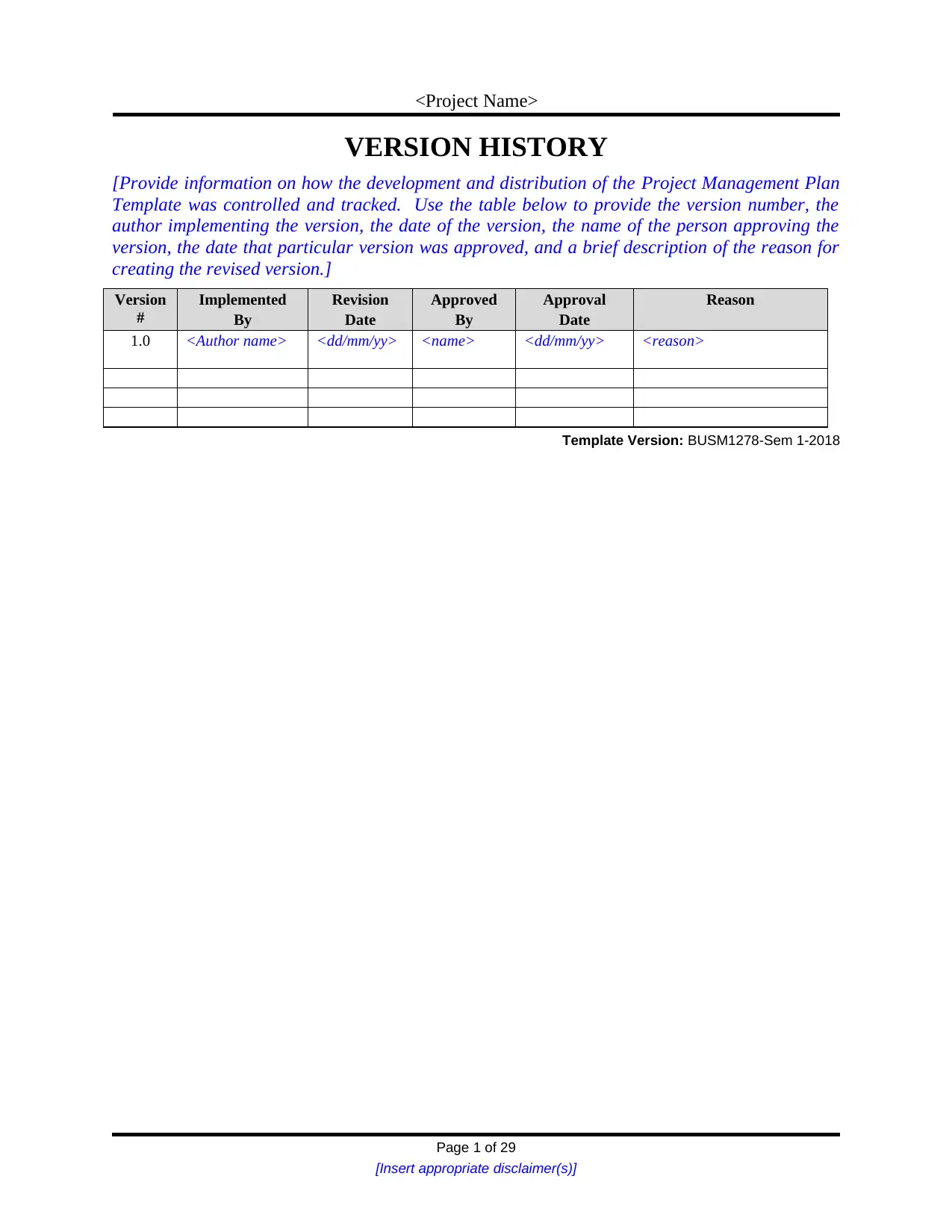
<Project Name>
VERSION HISTORY
[Provide information on how the development and distribution of the Project Management Plan
Template was controlled and tracked. Use the table below to provide the version number, the
author implementing the version, the date of the version, the name of the person approving the
version, the date that particular version was approved, and a brief description of the reason for
creating the revised version.]
Version
#
Implemented
By
Revision
Date
Approved
By
Approval
Date
Reason
1.0 <Author name> <dd/mm/yy> <name> <dd/mm/yy> <reason>
Template Version: BUSM1278-Sem 1-2018
Page 1 of 29
[Insert appropriate disclaimer(s)]
VERSION HISTORY
[Provide information on how the development and distribution of the Project Management Plan
Template was controlled and tracked. Use the table below to provide the version number, the
author implementing the version, the date of the version, the name of the person approving the
version, the date that particular version was approved, and a brief description of the reason for
creating the revised version.]
Version
#
Implemented
By
Revision
Date
Approved
By
Approval
Date
Reason
1.0 <Author name> <dd/mm/yy> <name> <dd/mm/yy> <reason>
Template Version: BUSM1278-Sem 1-2018
Page 1 of 29
[Insert appropriate disclaimer(s)]
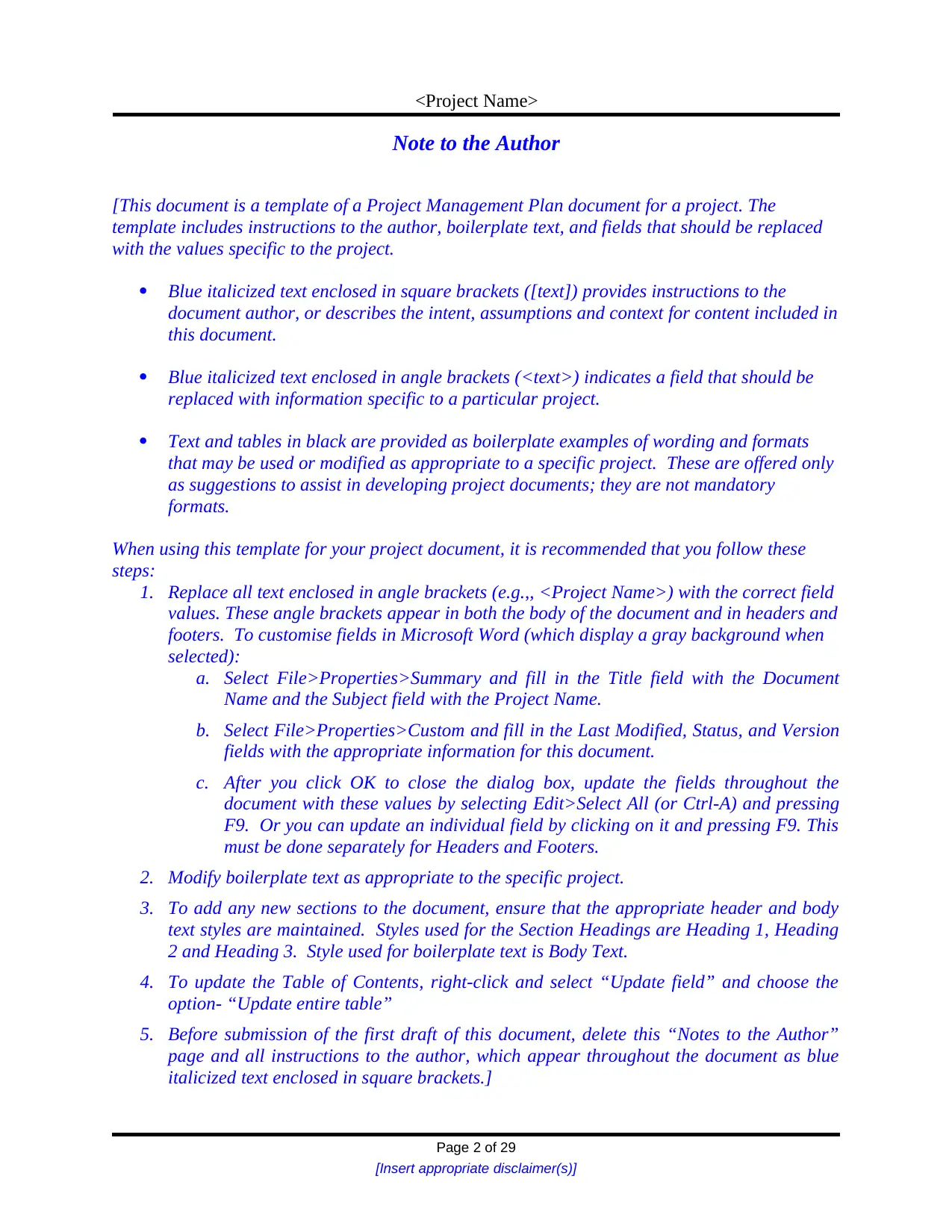
<Project Name>
Note to the Author
[This document is a template of a Project Management Plan document for a project. The
template includes instructions to the author, boilerplate text, and fields that should be replaced
with the values specific to the project.
Blue italicized text enclosed in square brackets ([text]) provides instructions to the
document author, or describes the intent, assumptions and context for content included in
this document.
Blue italicized text enclosed in angle brackets (<text>) indicates a field that should be
replaced with information specific to a particular project.
Text and tables in black are provided as boilerplate examples of wording and formats
that may be used or modified as appropriate to a specific project. These are offered only
as suggestions to assist in developing project documents; they are not mandatory
formats.
When using this template for your project document, it is recommended that you follow these
steps:
1. Replace all text enclosed in angle brackets (e.g.,, <Project Name>) with the correct field
values. These angle brackets appear in both the body of the document and in headers and
footers. To customise fields in Microsoft Word (which display a gray background when
selected):
a. Select File>Properties>Summary and fill in the Title field with the Document
Name and the Subject field with the Project Name.
b. Select File>Properties>Custom and fill in the Last Modified, Status, and Version
fields with the appropriate information for this document.
c. After you click OK to close the dialog box, update the fields throughout the
document with these values by selecting Edit>Select All (or Ctrl-A) and pressing
F9. Or you can update an individual field by clicking on it and pressing F9. This
must be done separately for Headers and Footers.
2. Modify boilerplate text as appropriate to the specific project.
3. To add any new sections to the document, ensure that the appropriate header and body
text styles are maintained. Styles used for the Section Headings are Heading 1, Heading
2 and Heading 3. Style used for boilerplate text is Body Text.
4. To update the Table of Contents, right-click and select “Update field” and choose the
option- “Update entire table”
5. Before submission of the first draft of this document, delete this “Notes to the Author”
page and all instructions to the author, which appear throughout the document as blue
italicized text enclosed in square brackets.]
Page 2 of 29
[Insert appropriate disclaimer(s)]
Note to the Author
[This document is a template of a Project Management Plan document for a project. The
template includes instructions to the author, boilerplate text, and fields that should be replaced
with the values specific to the project.
Blue italicized text enclosed in square brackets ([text]) provides instructions to the
document author, or describes the intent, assumptions and context for content included in
this document.
Blue italicized text enclosed in angle brackets (<text>) indicates a field that should be
replaced with information specific to a particular project.
Text and tables in black are provided as boilerplate examples of wording and formats
that may be used or modified as appropriate to a specific project. These are offered only
as suggestions to assist in developing project documents; they are not mandatory
formats.
When using this template for your project document, it is recommended that you follow these
steps:
1. Replace all text enclosed in angle brackets (e.g.,, <Project Name>) with the correct field
values. These angle brackets appear in both the body of the document and in headers and
footers. To customise fields in Microsoft Word (which display a gray background when
selected):
a. Select File>Properties>Summary and fill in the Title field with the Document
Name and the Subject field with the Project Name.
b. Select File>Properties>Custom and fill in the Last Modified, Status, and Version
fields with the appropriate information for this document.
c. After you click OK to close the dialog box, update the fields throughout the
document with these values by selecting Edit>Select All (or Ctrl-A) and pressing
F9. Or you can update an individual field by clicking on it and pressing F9. This
must be done separately for Headers and Footers.
2. Modify boilerplate text as appropriate to the specific project.
3. To add any new sections to the document, ensure that the appropriate header and body
text styles are maintained. Styles used for the Section Headings are Heading 1, Heading
2 and Heading 3. Style used for boilerplate text is Body Text.
4. To update the Table of Contents, right-click and select “Update field” and choose the
option- “Update entire table”
5. Before submission of the first draft of this document, delete this “Notes to the Author”
page and all instructions to the author, which appear throughout the document as blue
italicized text enclosed in square brackets.]
Page 2 of 29
[Insert appropriate disclaimer(s)]
⊘ This is a preview!⊘
Do you want full access?
Subscribe today to unlock all pages.

Trusted by 1+ million students worldwide
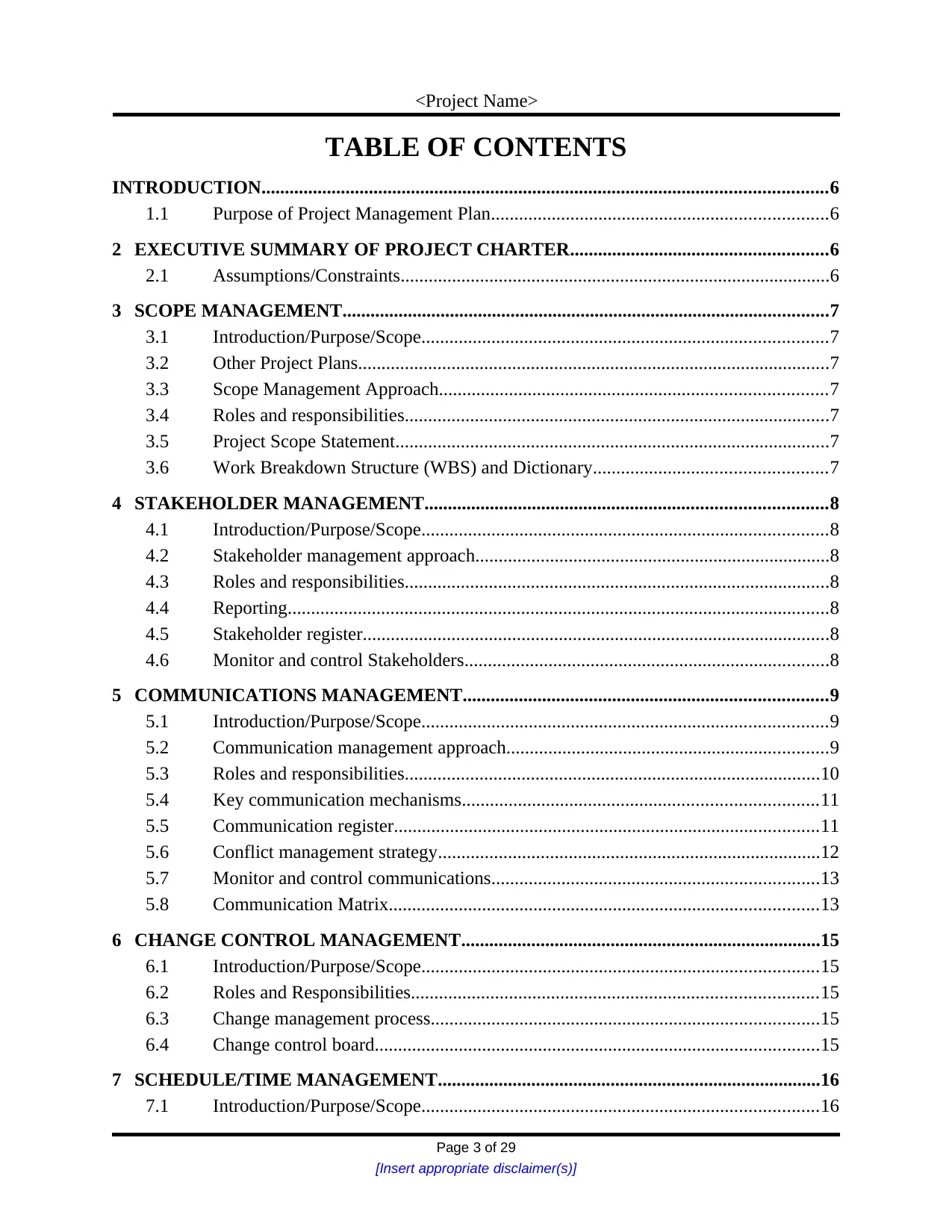
<Project Name>
TABLE OF CONTENTS
INTRODUCTION.........................................................................................................................6
1.1 Purpose of Project Management Plan........................................................................6
2 EXECUTIVE SUMMARY OF PROJECT CHARTER.......................................................6
2.1 Assumptions/Constraints............................................................................................6
3 SCOPE MANAGEMENT........................................................................................................7
3.1 Introduction/Purpose/Scope.......................................................................................7
3.2 Other Project Plans.....................................................................................................7
3.3 Scope Management Approach...................................................................................7
3.4 Roles and responsibilities...........................................................................................7
3.5 Project Scope Statement.............................................................................................7
3.6 Work Breakdown Structure (WBS) and Dictionary..................................................7
4 STAKEHOLDER MANAGEMENT......................................................................................8
4.1 Introduction/Purpose/Scope.......................................................................................8
4.2 Stakeholder management approach............................................................................8
4.3 Roles and responsibilities...........................................................................................8
4.4 Reporting....................................................................................................................8
4.5 Stakeholder register....................................................................................................8
4.6 Monitor and control Stakeholders..............................................................................8
5 COMMUNICATIONS MANAGEMENT..............................................................................9
5.1 Introduction/Purpose/Scope.......................................................................................9
5.2 Communication management approach.....................................................................9
5.3 Roles and responsibilities.........................................................................................10
5.4 Key communication mechanisms............................................................................11
5.5 Communication register...........................................................................................11
5.6 Conflict management strategy..................................................................................12
5.7 Monitor and control communications......................................................................13
5.8 Communication Matrix............................................................................................13
6 CHANGE CONTROL MANAGEMENT.............................................................................15
6.1 Introduction/Purpose/Scope.....................................................................................15
6.2 Roles and Responsibilities.......................................................................................15
6.3 Change management process...................................................................................15
6.4 Change control board...............................................................................................15
7 SCHEDULE/TIME MANAGEMENT..................................................................................16
7.1 Introduction/Purpose/Scope.....................................................................................16
Page 3 of 29
[Insert appropriate disclaimer(s)]
TABLE OF CONTENTS
INTRODUCTION.........................................................................................................................6
1.1 Purpose of Project Management Plan........................................................................6
2 EXECUTIVE SUMMARY OF PROJECT CHARTER.......................................................6
2.1 Assumptions/Constraints............................................................................................6
3 SCOPE MANAGEMENT........................................................................................................7
3.1 Introduction/Purpose/Scope.......................................................................................7
3.2 Other Project Plans.....................................................................................................7
3.3 Scope Management Approach...................................................................................7
3.4 Roles and responsibilities...........................................................................................7
3.5 Project Scope Statement.............................................................................................7
3.6 Work Breakdown Structure (WBS) and Dictionary..................................................7
4 STAKEHOLDER MANAGEMENT......................................................................................8
4.1 Introduction/Purpose/Scope.......................................................................................8
4.2 Stakeholder management approach............................................................................8
4.3 Roles and responsibilities...........................................................................................8
4.4 Reporting....................................................................................................................8
4.5 Stakeholder register....................................................................................................8
4.6 Monitor and control Stakeholders..............................................................................8
5 COMMUNICATIONS MANAGEMENT..............................................................................9
5.1 Introduction/Purpose/Scope.......................................................................................9
5.2 Communication management approach.....................................................................9
5.3 Roles and responsibilities.........................................................................................10
5.4 Key communication mechanisms............................................................................11
5.5 Communication register...........................................................................................11
5.6 Conflict management strategy..................................................................................12
5.7 Monitor and control communications......................................................................13
5.8 Communication Matrix............................................................................................13
6 CHANGE CONTROL MANAGEMENT.............................................................................15
6.1 Introduction/Purpose/Scope.....................................................................................15
6.2 Roles and Responsibilities.......................................................................................15
6.3 Change management process...................................................................................15
6.4 Change control board...............................................................................................15
7 SCHEDULE/TIME MANAGEMENT..................................................................................16
7.1 Introduction/Purpose/Scope.....................................................................................16
Page 3 of 29
[Insert appropriate disclaimer(s)]
Paraphrase This Document
Need a fresh take? Get an instant paraphrase of this document with our AI Paraphraser
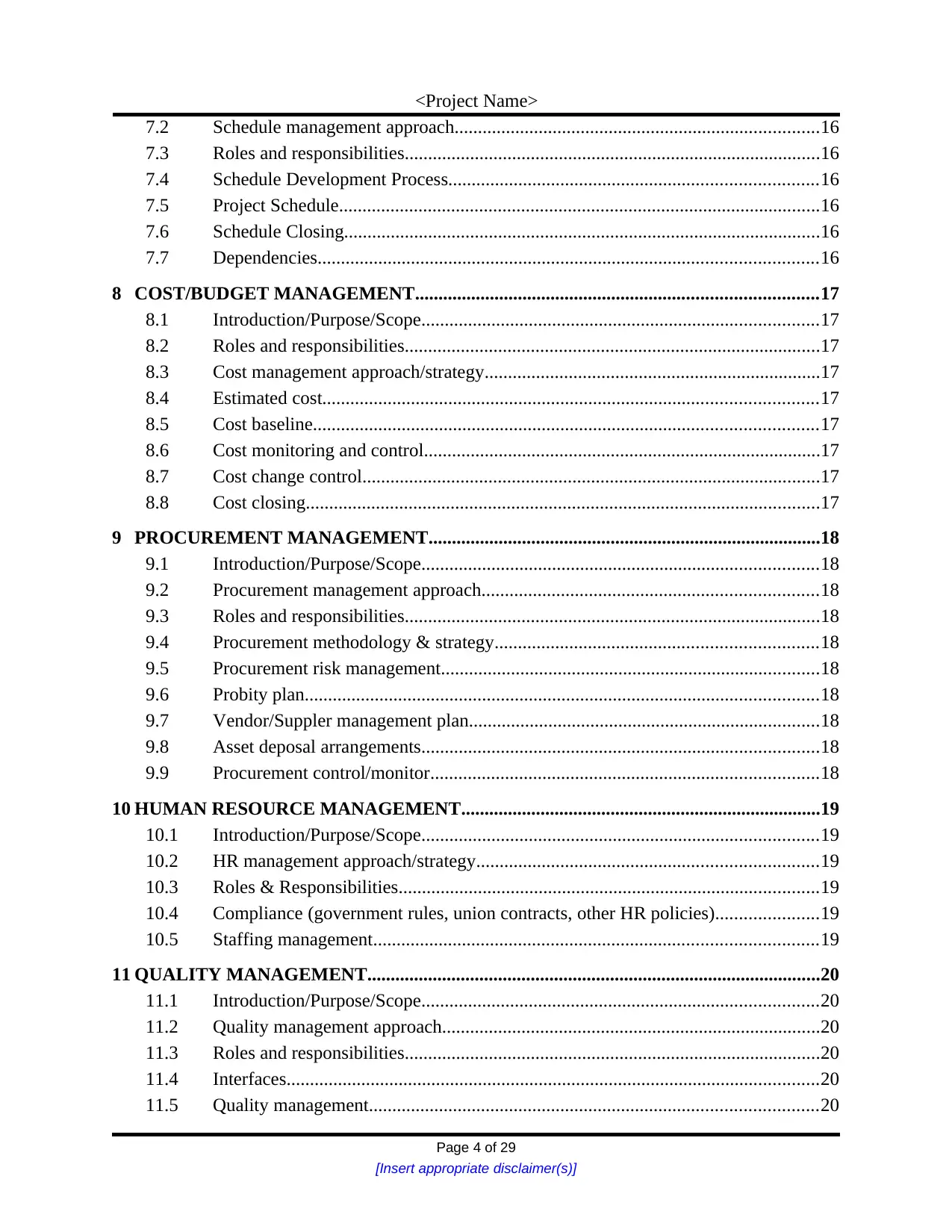
<Project Name>
7.2 Schedule management approach..............................................................................16
7.3 Roles and responsibilities.........................................................................................16
7.4 Schedule Development Process...............................................................................16
7.5 Project Schedule.......................................................................................................16
7.6 Schedule Closing......................................................................................................16
7.7 Dependencies...........................................................................................................16
8 COST/BUDGET MANAGEMENT......................................................................................17
8.1 Introduction/Purpose/Scope.....................................................................................17
8.2 Roles and responsibilities.........................................................................................17
8.3 Cost management approach/strategy........................................................................17
8.4 Estimated cost..........................................................................................................17
8.5 Cost baseline............................................................................................................17
8.6 Cost monitoring and control.....................................................................................17
8.7 Cost change control..................................................................................................17
8.8 Cost closing..............................................................................................................17
9 PROCUREMENT MANAGEMENT....................................................................................18
9.1 Introduction/Purpose/Scope.....................................................................................18
9.2 Procurement management approach........................................................................18
9.3 Roles and responsibilities.........................................................................................18
9.4 Procurement methodology & strategy.....................................................................18
9.5 Procurement risk management.................................................................................18
9.6 Probity plan..............................................................................................................18
9.7 Vendor/Suppler management plan...........................................................................18
9.8 Asset deposal arrangements.....................................................................................18
9.9 Procurement control/monitor...................................................................................18
10 HUMAN RESOURCE MANAGEMENT.............................................................................19
10.1 Introduction/Purpose/Scope.....................................................................................19
10.2 HR management approach/strategy.........................................................................19
10.3 Roles & Responsibilities..........................................................................................19
10.4 Compliance (government rules, union contracts, other HR policies)......................19
10.5 Staffing management...............................................................................................19
11 QUALITY MANAGEMENT.................................................................................................20
11.1 Introduction/Purpose/Scope.....................................................................................20
11.2 Quality management approach.................................................................................20
11.3 Roles and responsibilities.........................................................................................20
11.4 Interfaces..................................................................................................................20
11.5 Quality management................................................................................................20
Page 4 of 29
[Insert appropriate disclaimer(s)]
7.2 Schedule management approach..............................................................................16
7.3 Roles and responsibilities.........................................................................................16
7.4 Schedule Development Process...............................................................................16
7.5 Project Schedule.......................................................................................................16
7.6 Schedule Closing......................................................................................................16
7.7 Dependencies...........................................................................................................16
8 COST/BUDGET MANAGEMENT......................................................................................17
8.1 Introduction/Purpose/Scope.....................................................................................17
8.2 Roles and responsibilities.........................................................................................17
8.3 Cost management approach/strategy........................................................................17
8.4 Estimated cost..........................................................................................................17
8.5 Cost baseline............................................................................................................17
8.6 Cost monitoring and control.....................................................................................17
8.7 Cost change control..................................................................................................17
8.8 Cost closing..............................................................................................................17
9 PROCUREMENT MANAGEMENT....................................................................................18
9.1 Introduction/Purpose/Scope.....................................................................................18
9.2 Procurement management approach........................................................................18
9.3 Roles and responsibilities.........................................................................................18
9.4 Procurement methodology & strategy.....................................................................18
9.5 Procurement risk management.................................................................................18
9.6 Probity plan..............................................................................................................18
9.7 Vendor/Suppler management plan...........................................................................18
9.8 Asset deposal arrangements.....................................................................................18
9.9 Procurement control/monitor...................................................................................18
10 HUMAN RESOURCE MANAGEMENT.............................................................................19
10.1 Introduction/Purpose/Scope.....................................................................................19
10.2 HR management approach/strategy.........................................................................19
10.3 Roles & Responsibilities..........................................................................................19
10.4 Compliance (government rules, union contracts, other HR policies)......................19
10.5 Staffing management...............................................................................................19
11 QUALITY MANAGEMENT.................................................................................................20
11.1 Introduction/Purpose/Scope.....................................................................................20
11.2 Quality management approach.................................................................................20
11.3 Roles and responsibilities.........................................................................................20
11.4 Interfaces..................................................................................................................20
11.5 Quality management................................................................................................20
Page 4 of 29
[Insert appropriate disclaimer(s)]
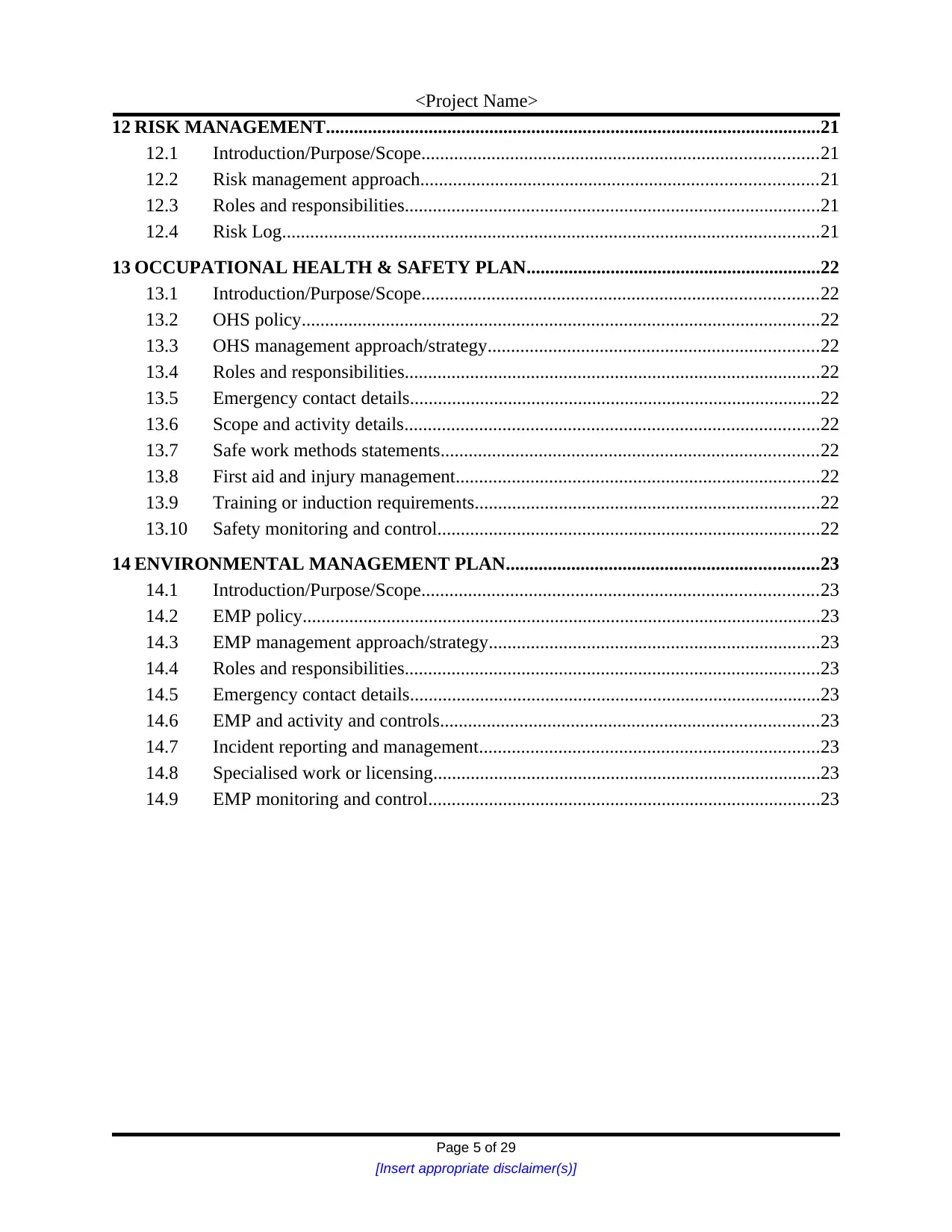
<Project Name>
12 RISK MANAGEMENT..........................................................................................................21
12.1 Introduction/Purpose/Scope.....................................................................................21
12.2 Risk management approach.....................................................................................21
12.3 Roles and responsibilities.........................................................................................21
12.4 Risk Log...................................................................................................................21
13 OCCUPATIONAL HEALTH & SAFETY PLAN...............................................................22
13.1 Introduction/Purpose/Scope.....................................................................................22
13.2 OHS policy...............................................................................................................22
13.3 OHS management approach/strategy.......................................................................22
13.4 Roles and responsibilities.........................................................................................22
13.5 Emergency contact details........................................................................................22
13.6 Scope and activity details.........................................................................................22
13.7 Safe work methods statements.................................................................................22
13.8 First aid and injury management..............................................................................22
13.9 Training or induction requirements..........................................................................22
13.10 Safety monitoring and control..................................................................................22
14 ENVIRONMENTAL MANAGEMENT PLAN...................................................................23
14.1 Introduction/Purpose/Scope.....................................................................................23
14.2 EMP policy...............................................................................................................23
14.3 EMP management approach/strategy.......................................................................23
14.4 Roles and responsibilities.........................................................................................23
14.5 Emergency contact details........................................................................................23
14.6 EMP and activity and controls.................................................................................23
14.7 Incident reporting and management.........................................................................23
14.8 Specialised work or licensing...................................................................................23
14.9 EMP monitoring and control....................................................................................23
Page 5 of 29
[Insert appropriate disclaimer(s)]
12 RISK MANAGEMENT..........................................................................................................21
12.1 Introduction/Purpose/Scope.....................................................................................21
12.2 Risk management approach.....................................................................................21
12.3 Roles and responsibilities.........................................................................................21
12.4 Risk Log...................................................................................................................21
13 OCCUPATIONAL HEALTH & SAFETY PLAN...............................................................22
13.1 Introduction/Purpose/Scope.....................................................................................22
13.2 OHS policy...............................................................................................................22
13.3 OHS management approach/strategy.......................................................................22
13.4 Roles and responsibilities.........................................................................................22
13.5 Emergency contact details........................................................................................22
13.6 Scope and activity details.........................................................................................22
13.7 Safe work methods statements.................................................................................22
13.8 First aid and injury management..............................................................................22
13.9 Training or induction requirements..........................................................................22
13.10 Safety monitoring and control..................................................................................22
14 ENVIRONMENTAL MANAGEMENT PLAN...................................................................23
14.1 Introduction/Purpose/Scope.....................................................................................23
14.2 EMP policy...............................................................................................................23
14.3 EMP management approach/strategy.......................................................................23
14.4 Roles and responsibilities.........................................................................................23
14.5 Emergency contact details........................................................................................23
14.6 EMP and activity and controls.................................................................................23
14.7 Incident reporting and management.........................................................................23
14.8 Specialised work or licensing...................................................................................23
14.9 EMP monitoring and control....................................................................................23
Page 5 of 29
[Insert appropriate disclaimer(s)]
⊘ This is a preview!⊘
Do you want full access?
Subscribe today to unlock all pages.

Trusted by 1+ million students worldwide
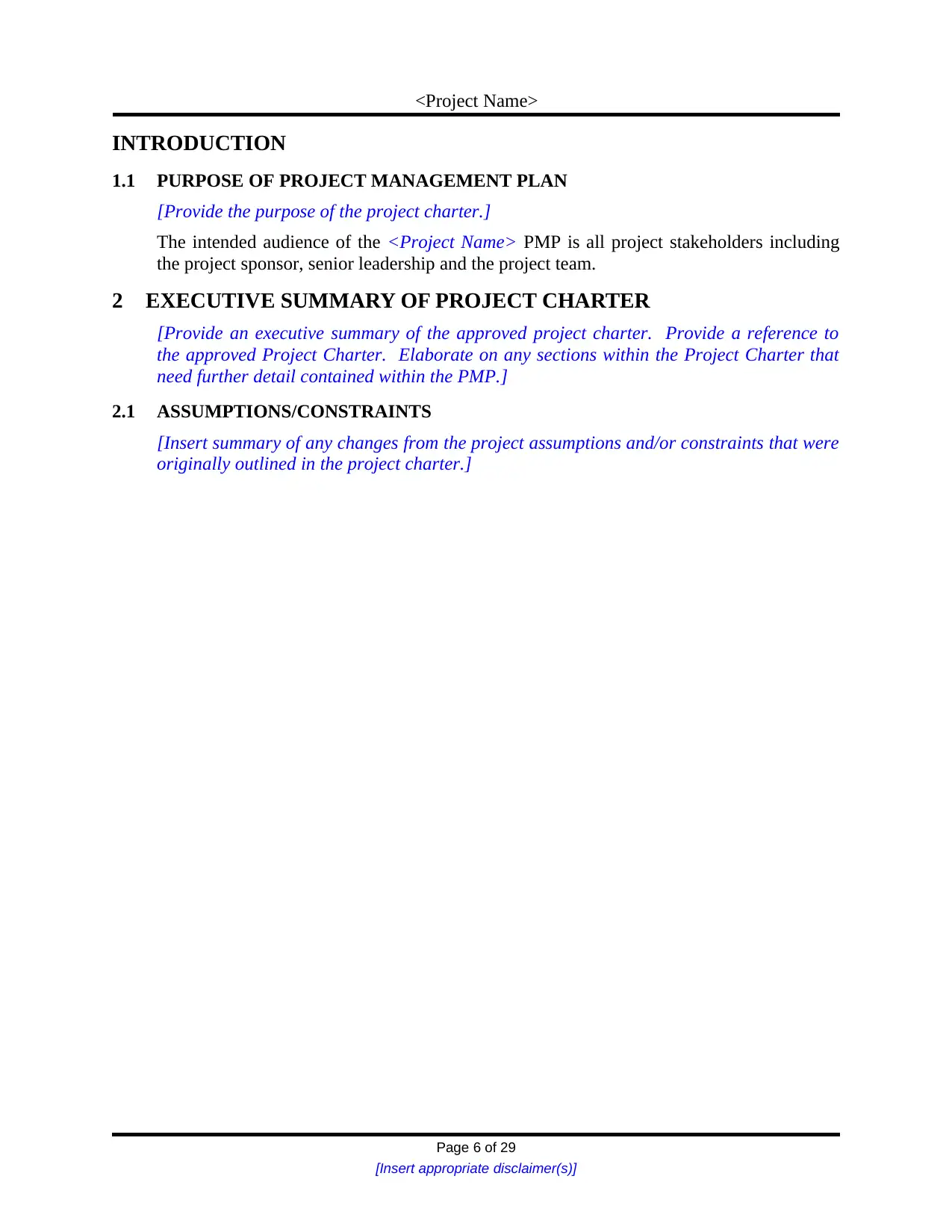
<Project Name>
INTRODUCTION
1.1 PURPOSE OF PROJECT MANAGEMENT PLAN
[Provide the purpose of the project charter.]
The intended audience of the <Project Name> PMP is all project stakeholders including
the project sponsor, senior leadership and the project team.
2 EXECUTIVE SUMMARY OF PROJECT CHARTER
[Provide an executive summary of the approved project charter. Provide a reference to
the approved Project Charter. Elaborate on any sections within the Project Charter that
need further detail contained within the PMP.]
2.1 ASSUMPTIONS/CONSTRAINTS
[Insert summary of any changes from the project assumptions and/or constraints that were
originally outlined in the project charter.]
Page 6 of 29
[Insert appropriate disclaimer(s)]
INTRODUCTION
1.1 PURPOSE OF PROJECT MANAGEMENT PLAN
[Provide the purpose of the project charter.]
The intended audience of the <Project Name> PMP is all project stakeholders including
the project sponsor, senior leadership and the project team.
2 EXECUTIVE SUMMARY OF PROJECT CHARTER
[Provide an executive summary of the approved project charter. Provide a reference to
the approved Project Charter. Elaborate on any sections within the Project Charter that
need further detail contained within the PMP.]
2.1 ASSUMPTIONS/CONSTRAINTS
[Insert summary of any changes from the project assumptions and/or constraints that were
originally outlined in the project charter.]
Page 6 of 29
[Insert appropriate disclaimer(s)]
Paraphrase This Document
Need a fresh take? Get an instant paraphrase of this document with our AI Paraphraser
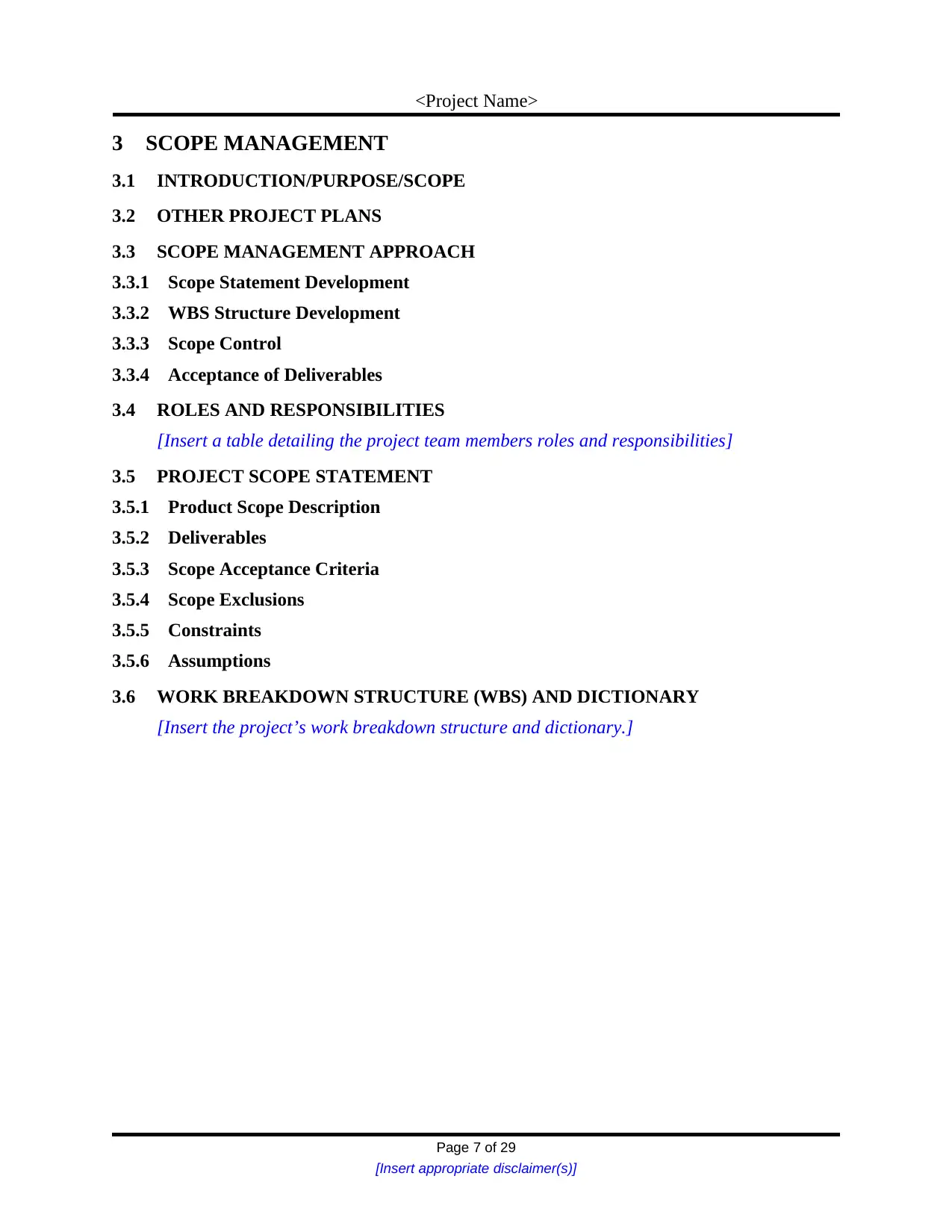
<Project Name>
3 SCOPE MANAGEMENT
3.1 INTRODUCTION/PURPOSE/SCOPE
3.2 OTHER PROJECT PLANS
3.3 SCOPE MANAGEMENT APPROACH
3.3.1 Scope Statement Development
3.3.2 WBS Structure Development
3.3.3 Scope Control
3.3.4 Acceptance of Deliverables
3.4 ROLES AND RESPONSIBILITIES
[Insert a table detailing the project team members roles and responsibilities]
3.5 PROJECT SCOPE STATEMENT
3.5.1 Product Scope Description
3.5.2 Deliverables
3.5.3 Scope Acceptance Criteria
3.5.4 Scope Exclusions
3.5.5 Constraints
3.5.6 Assumptions
3.6 WORK BREAKDOWN STRUCTURE (WBS) AND DICTIONARY
[Insert the project’s work breakdown structure and dictionary.]
Page 7 of 29
[Insert appropriate disclaimer(s)]
3 SCOPE MANAGEMENT
3.1 INTRODUCTION/PURPOSE/SCOPE
3.2 OTHER PROJECT PLANS
3.3 SCOPE MANAGEMENT APPROACH
3.3.1 Scope Statement Development
3.3.2 WBS Structure Development
3.3.3 Scope Control
3.3.4 Acceptance of Deliverables
3.4 ROLES AND RESPONSIBILITIES
[Insert a table detailing the project team members roles and responsibilities]
3.5 PROJECT SCOPE STATEMENT
3.5.1 Product Scope Description
3.5.2 Deliverables
3.5.3 Scope Acceptance Criteria
3.5.4 Scope Exclusions
3.5.5 Constraints
3.5.6 Assumptions
3.6 WORK BREAKDOWN STRUCTURE (WBS) AND DICTIONARY
[Insert the project’s work breakdown structure and dictionary.]
Page 7 of 29
[Insert appropriate disclaimer(s)]
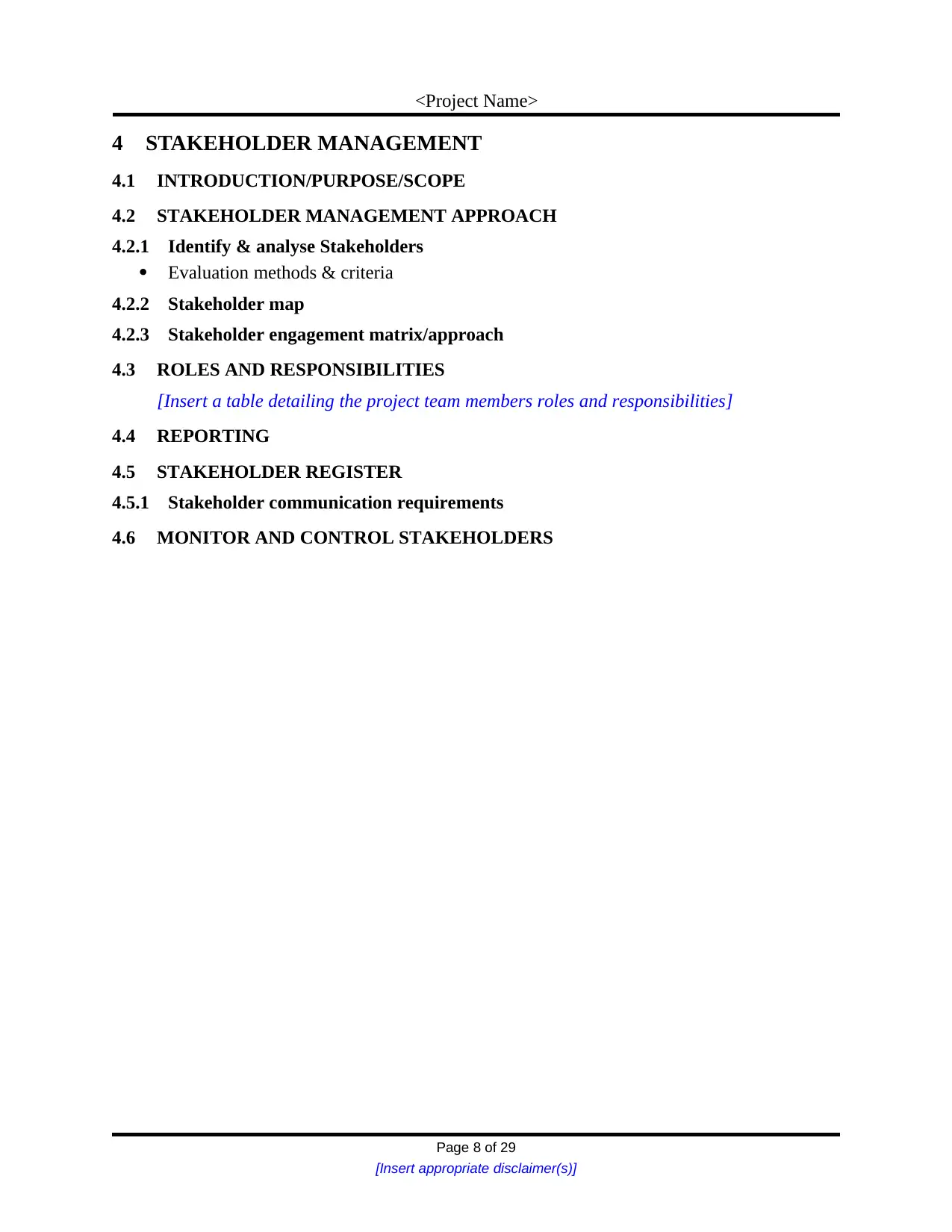
<Project Name>
4 STAKEHOLDER MANAGEMENT
4.1 INTRODUCTION/PURPOSE/SCOPE
4.2 STAKEHOLDER MANAGEMENT APPROACH
4.2.1 Identify & analyse Stakeholders
Evaluation methods & criteria
4.2.2 Stakeholder map
4.2.3 Stakeholder engagement matrix/approach
4.3 ROLES AND RESPONSIBILITIES
[Insert a table detailing the project team members roles and responsibilities]
4.4 REPORTING
4.5 STAKEHOLDER REGISTER
4.5.1 Stakeholder communication requirements
4.6 MONITOR AND CONTROL STAKEHOLDERS
Page 8 of 29
[Insert appropriate disclaimer(s)]
4 STAKEHOLDER MANAGEMENT
4.1 INTRODUCTION/PURPOSE/SCOPE
4.2 STAKEHOLDER MANAGEMENT APPROACH
4.2.1 Identify & analyse Stakeholders
Evaluation methods & criteria
4.2.2 Stakeholder map
4.2.3 Stakeholder engagement matrix/approach
4.3 ROLES AND RESPONSIBILITIES
[Insert a table detailing the project team members roles and responsibilities]
4.4 REPORTING
4.5 STAKEHOLDER REGISTER
4.5.1 Stakeholder communication requirements
4.6 MONITOR AND CONTROL STAKEHOLDERS
Page 8 of 29
[Insert appropriate disclaimer(s)]
⊘ This is a preview!⊘
Do you want full access?
Subscribe today to unlock all pages.

Trusted by 1+ million students worldwide
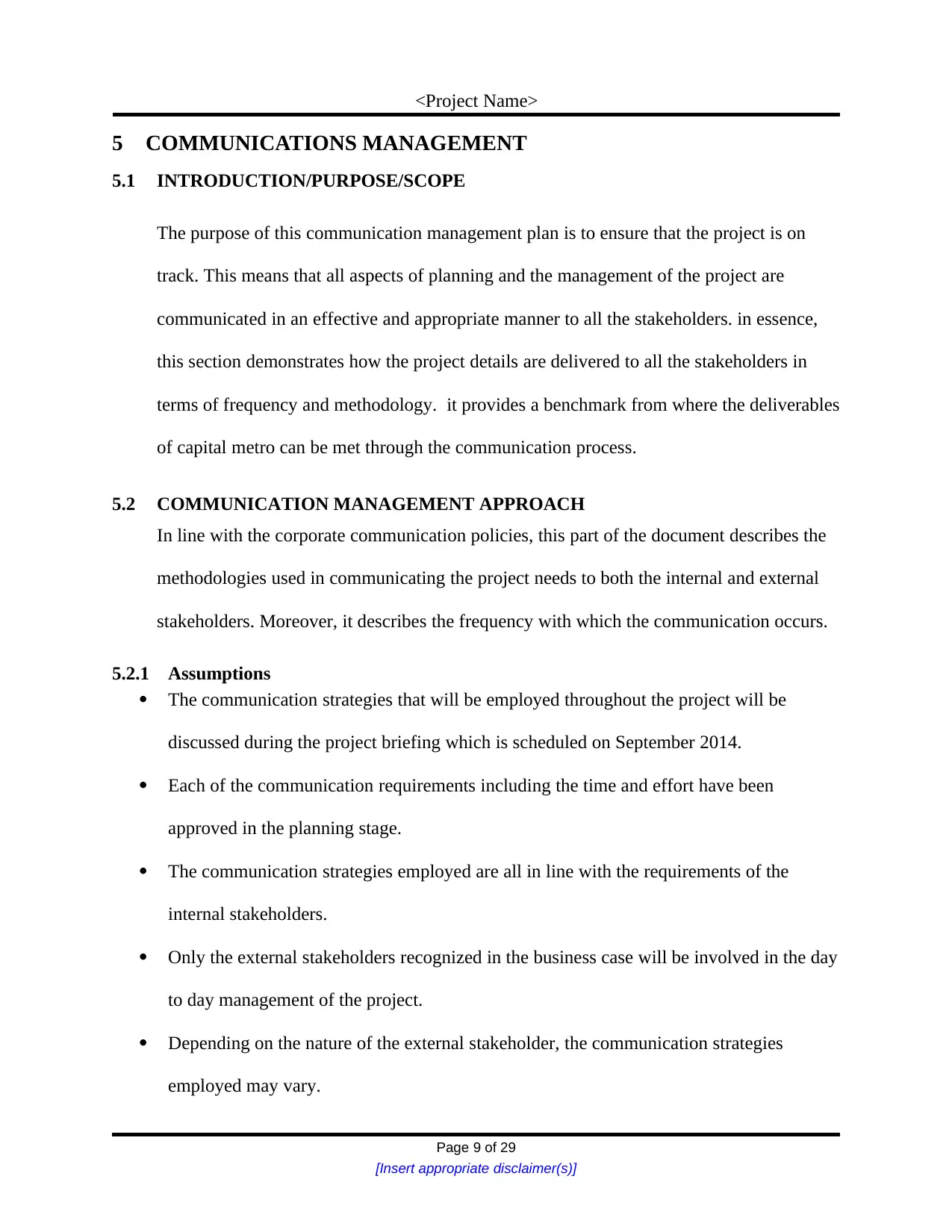
<Project Name>
5 COMMUNICATIONS MANAGEMENT
5.1 INTRODUCTION/PURPOSE/SCOPE
The purpose of this communication management plan is to ensure that the project is on
track. This means that all aspects of planning and the management of the project are
communicated in an effective and appropriate manner to all the stakeholders. in essence,
this section demonstrates how the project details are delivered to all the stakeholders in
terms of frequency and methodology. it provides a benchmark from where the deliverables
of capital metro can be met through the communication process.
5.2 COMMUNICATION MANAGEMENT APPROACH
In line with the corporate communication policies, this part of the document describes the
methodologies used in communicating the project needs to both the internal and external
stakeholders. Moreover, it describes the frequency with which the communication occurs.
5.2.1 Assumptions
The communication strategies that will be employed throughout the project will be
discussed during the project briefing which is scheduled on September 2014.
Each of the communication requirements including the time and effort have been
approved in the planning stage.
The communication strategies employed are all in line with the requirements of the
internal stakeholders.
Only the external stakeholders recognized in the business case will be involved in the day
to day management of the project.
Depending on the nature of the external stakeholder, the communication strategies
employed may vary.
Page 9 of 29
[Insert appropriate disclaimer(s)]
5 COMMUNICATIONS MANAGEMENT
5.1 INTRODUCTION/PURPOSE/SCOPE
The purpose of this communication management plan is to ensure that the project is on
track. This means that all aspects of planning and the management of the project are
communicated in an effective and appropriate manner to all the stakeholders. in essence,
this section demonstrates how the project details are delivered to all the stakeholders in
terms of frequency and methodology. it provides a benchmark from where the deliverables
of capital metro can be met through the communication process.
5.2 COMMUNICATION MANAGEMENT APPROACH
In line with the corporate communication policies, this part of the document describes the
methodologies used in communicating the project needs to both the internal and external
stakeholders. Moreover, it describes the frequency with which the communication occurs.
5.2.1 Assumptions
The communication strategies that will be employed throughout the project will be
discussed during the project briefing which is scheduled on September 2014.
Each of the communication requirements including the time and effort have been
approved in the planning stage.
The communication strategies employed are all in line with the requirements of the
internal stakeholders.
Only the external stakeholders recognized in the business case will be involved in the day
to day management of the project.
Depending on the nature of the external stakeholder, the communication strategies
employed may vary.
Page 9 of 29
[Insert appropriate disclaimer(s)]
Paraphrase This Document
Need a fresh take? Get an instant paraphrase of this document with our AI Paraphraser
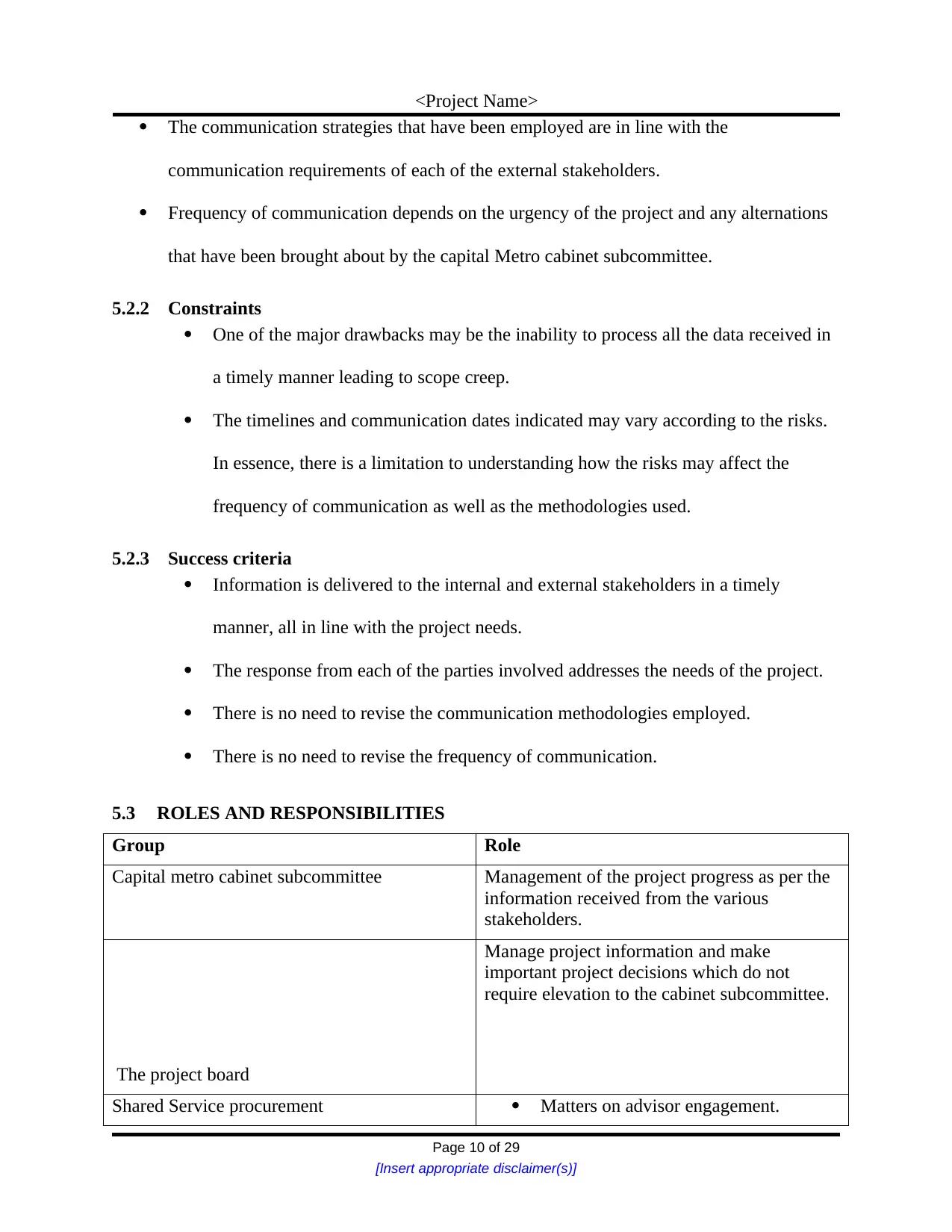
<Project Name>
The communication strategies that have been employed are in line with the
communication requirements of each of the external stakeholders.
Frequency of communication depends on the urgency of the project and any alternations
that have been brought about by the capital Metro cabinet subcommittee.
5.2.2 Constraints
One of the major drawbacks may be the inability to process all the data received in
a timely manner leading to scope creep.
The timelines and communication dates indicated may vary according to the risks.
In essence, there is a limitation to understanding how the risks may affect the
frequency of communication as well as the methodologies used.
5.2.3 Success criteria
Information is delivered to the internal and external stakeholders in a timely
manner, all in line with the project needs.
The response from each of the parties involved addresses the needs of the project.
There is no need to revise the communication methodologies employed.
There is no need to revise the frequency of communication.
5.3 ROLES AND RESPONSIBILITIES
Group Role
Capital metro cabinet subcommittee Management of the project progress as per the
information received from the various
stakeholders.
The project board
Manage project information and make
important project decisions which do not
require elevation to the cabinet subcommittee.
Shared Service procurement Matters on advisor engagement.
Page 10 of 29
[Insert appropriate disclaimer(s)]
The communication strategies that have been employed are in line with the
communication requirements of each of the external stakeholders.
Frequency of communication depends on the urgency of the project and any alternations
that have been brought about by the capital Metro cabinet subcommittee.
5.2.2 Constraints
One of the major drawbacks may be the inability to process all the data received in
a timely manner leading to scope creep.
The timelines and communication dates indicated may vary according to the risks.
In essence, there is a limitation to understanding how the risks may affect the
frequency of communication as well as the methodologies used.
5.2.3 Success criteria
Information is delivered to the internal and external stakeholders in a timely
manner, all in line with the project needs.
The response from each of the parties involved addresses the needs of the project.
There is no need to revise the communication methodologies employed.
There is no need to revise the frequency of communication.
5.3 ROLES AND RESPONSIBILITIES
Group Role
Capital metro cabinet subcommittee Management of the project progress as per the
information received from the various
stakeholders.
The project board
Manage project information and make
important project decisions which do not
require elevation to the cabinet subcommittee.
Shared Service procurement Matters on advisor engagement.
Page 10 of 29
[Insert appropriate disclaimer(s)]
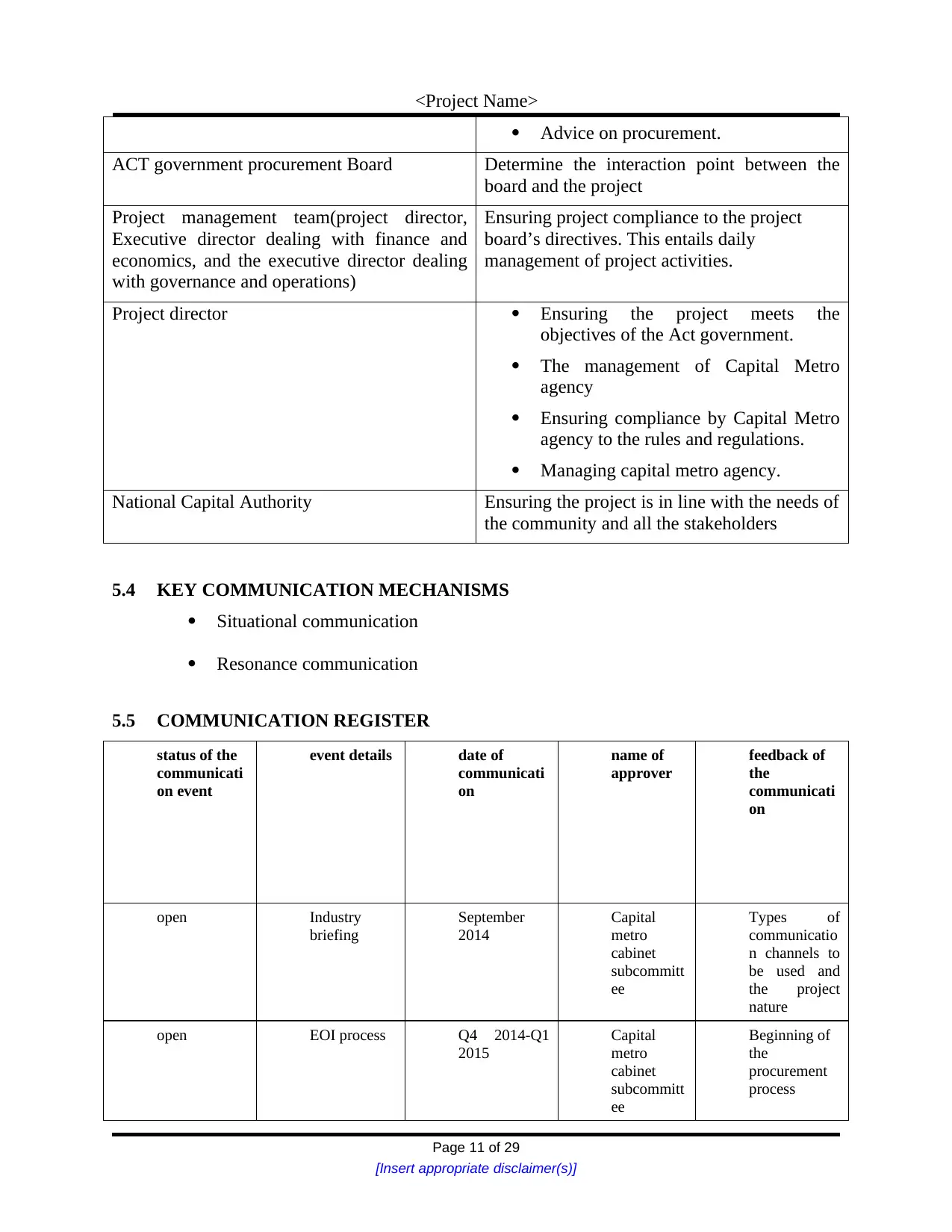
<Project Name>
Advice on procurement.
ACT government procurement Board Determine the interaction point between the
board and the project
Project management team(project director,
Executive director dealing with finance and
economics, and the executive director dealing
with governance and operations)
Ensuring project compliance to the project
board’s directives. This entails daily
management of project activities.
Project director Ensuring the project meets the
objectives of the Act government.
The management of Capital Metro
agency
Ensuring compliance by Capital Metro
agency to the rules and regulations.
Managing capital metro agency.
National Capital Authority Ensuring the project is in line with the needs of
the community and all the stakeholders
5.4 KEY COMMUNICATION MECHANISMS
Situational communication
Resonance communication
5.5 COMMUNICATION REGISTER
status of the
communicati
on event
event details date of
communicati
on
name of
approver
feedback of
the
communicati
on
open Industry
briefing
September
2014
Capital
metro
cabinet
subcommitt
ee
Types of
communicatio
n channels to
be used and
the project
nature
open EOI process Q4 2014-Q1
2015
Capital
metro
cabinet
subcommitt
ee
Beginning of
the
procurement
process
Page 11 of 29
[Insert appropriate disclaimer(s)]
Advice on procurement.
ACT government procurement Board Determine the interaction point between the
board and the project
Project management team(project director,
Executive director dealing with finance and
economics, and the executive director dealing
with governance and operations)
Ensuring project compliance to the project
board’s directives. This entails daily
management of project activities.
Project director Ensuring the project meets the
objectives of the Act government.
The management of Capital Metro
agency
Ensuring compliance by Capital Metro
agency to the rules and regulations.
Managing capital metro agency.
National Capital Authority Ensuring the project is in line with the needs of
the community and all the stakeholders
5.4 KEY COMMUNICATION MECHANISMS
Situational communication
Resonance communication
5.5 COMMUNICATION REGISTER
status of the
communicati
on event
event details date of
communicati
on
name of
approver
feedback of
the
communicati
on
open Industry
briefing
September
2014
Capital
metro
cabinet
subcommitt
ee
Types of
communicatio
n channels to
be used and
the project
nature
open EOI process Q4 2014-Q1
2015
Capital
metro
cabinet
subcommitt
ee
Beginning of
the
procurement
process
Page 11 of 29
[Insert appropriate disclaimer(s)]
⊘ This is a preview!⊘
Do you want full access?
Subscribe today to unlock all pages.

Trusted by 1+ million students worldwide
1 out of 28
Related Documents
Your All-in-One AI-Powered Toolkit for Academic Success.
+13062052269
info@desklib.com
Available 24*7 on WhatsApp / Email
![[object Object]](/_next/static/media/star-bottom.7253800d.svg)
Unlock your academic potential
Copyright © 2020–2025 A2Z Services. All Rights Reserved. Developed and managed by ZUCOL.





